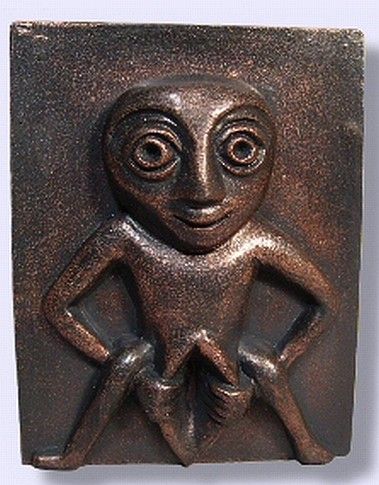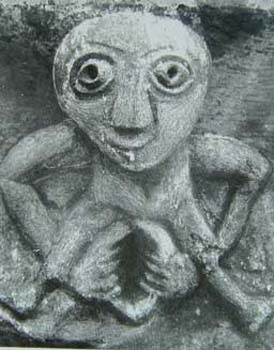Visualizing Birth through the Sheela-na-gig
The Sheela-na-gig was one of the first birth images covered back in 2010 when I started this blog. Since that time, I have learned much more about the figure. In addition to its acknowledgment in popular, contemporary birth literature, interest in the sheela figure has gained traction in the academic community. At the Reimagining Birth conference in Ireland last year, I had the opportunity to meet with a few scholars interested in sheelas. Although the origins of the sheelas remain unknown, much interesting research has been conducted to explore the significance of the figures. As I described in my first post, the Sheela-na-gig is an image of profound importance and practical usage in the visualization of birth, a topic that Ina May Gaskin explains in her Guide to Childbirth (see my earlier post for some of Ina May’s writing on the Sheela).
Today, I provide some of my current research on the Sheela-na-gig for readers here at Visualizing Birth. The sheela figures are fascinating, not only in light of their enigmatic history but also insofar as women today are actively using them within the contemporary context of birth as a rite of passage. Like others of its kind, the plaque image of the Kilpek sheela shown above is available for sale and popular consumption. The availability of these objects is an attestation that there is strong interest in using them for birth and the visualization of birth.
The Sheela-na-gig is a specific type of stone figure carving identifiable by the figure’s large vulva, which opens widely, some say grotesquely, while others claim it to represent the act of birth.[1] Originally found in Ireland, Britain and on mainland Europe, the figures, also known simply as “sheelas,” measure between 9 and 90 cm and are still present in old churches, churchyards and other fortifications.[2] The majority of extant figures are in Ireland, which contains at least 110, with approximately 40 others in England and a handful more in Scotland, Wales, Denmark, Germany and France.[3] Scholars generally agree that the figures date from the twelfth to the sixteenth centuries, although some have suggested dating as early as the sixth and seventh centuries.[4] The figures are bald with an upper bony body suggestive of old age. Much of the literature describes them as “crones” or “hags.” Aside from these features associated with old age, however, the Sheela-na-gig’s most distinctive characteristic is its full and enlarged vulva, which is suggestive of vitality and youth. Centered on the body and typically held open by the sheela’s own hands, the vulva becomes the focal point of the object. The original meaning and purpose of the sheelas remain unknown, and contesting theories as to their origins have circulated since the objects first came to scholarly attention in Ireland during the mid-nineteenth century. Speculation and interest in the figure and its meaning have surged in various disciplines over the past two decades. Although a diverse range of theories exist on the subject, they tend to split in three general directions: (1) sheelas represent female divinity and motifs of birth and fertility stemming from pagan understandings of female power; (2) they are connected to Christian warnings against lust and sin as propagated by the medieval Catholic Church; or (3) they are associated with apotropaic devices used within the Church to ward off evil. Within these divisions, scholars have effectively perceived of the Sheela-na-gig and its representation of the female body as either sacred, profane, or a combination of the two. In all cases, a common thread emerges to interpret the object’s historical meaning: the Sheela-na-gig’s ontology is bound to the sacred-profane dichotomy present in modern concepts of religion.[5]
Yet although the focus on these religious images appears to revolve around the secular aspects of birth, the visualization of birth and labor takes part ritualistically in birth as a rite of passage, and the ritualistic role that these images may play in birth as a rite of passage cannot be ignored. These images and others like them, originally used in contexts associated with religion, are now being transplanted in a trans-religious, transnational and trans-historical way such that they are not only secularized, but are also re-sacralized during the rituals of birth. To understand this process between the sacred and the secular, we must explore ritual in birth as a rite of passage. I contend that the use of images like the two just mentioned plays an integral part in how some women are today preparing ritualistically, as well as practically, for birth.
[1] The term, Sheela-na-gig, is the anglicized form of the Irish term Sigla na gćioch, which is often translated as “Sheela of the Breasts.” For a detailed discussion of the problem of meaning in the name, “Sheela-na-gig,” including alternative meanings, see Barbara Freitag’s, Sheela-Na-Gigs: Unravelling an Enigma, London and New York: Routledge, 2004, 52-67; or Georgia Rhoades, “Decoding the Sheela-na-gig,” Feminist Formations 22, no.2 (Summer 2010), 167-194. Renowned midwife, Ina May Gaskin, for example, describes the utility of the sheela figure, “My idea is that this figure was probably meant to reassure young women about the capabilities of their bodies in birth. Ellen Predergast, in an article written for an Irish journal, remarked, ‘After a lifetime’s awareness of such figures I am convinced their significance lies in the sphere of fertility, and that is what is depicted…is the act of giving birth.’ Whether Ms. Predergast and I are right or not, I can testify that a sheela-na-gig figure can be a great help at a birth. As you can see, the vulva of the crouching figure is open enough to accommodate her own head. Such a sight is quite encouraging to a woman in labor” (Ina May Gaskin, Ina May’s Guide to Childbirth, New York: Bantam Books, 2003, p. 253).
[2] Barbara Freitag, Sheela-na-gigs: Unravelling an Enigma, London: Routledge, 2004, 3.
[3] Ibid. 4.
[4] Jack Roberts and Joanne McMahon, authors of An Illustrated Map of the Sheela-na-Gigs of Britain and Ireland (1997) believe some of the sheelas to date back to as early as the sixth century CE, and early twentieth-century folklorist, Edith Guest, also suggests dates as early as the seventh century CE (Rhoades 167-168).
[5] Broadly speaking, the division between the sacred and profane stems from Emile Durkheim’s discussion of the dichotomy in his Elementary Forms of the Religious Life (1912).


Our society is so centered on being special, that our tech is an amazing and wonderful thing that nobody in history could have done, and people overlook the truth that ‘cave men’ were just as intelligent and creative as we are, in fact, few of us possess the skills and encyclopedic knowledge that they needed just to live from day to day. My point being that this thing we call ‘Christianity’ was built by integrating the beliefs of the subject masses as it expanded, just to keep the people from turning away and shaking their heads at these crazy interlopers. All of our holidays were already in place, they just dotted the i’s and crossed the t’s and made them their own- every single one of these holidays that we observe now, and many, many that have fallen by the wayside. So using the form of the ‘Sheelas’ was another of those accepted beliefs, (our ‘modern’ form of intolerance for anything beyond a sharp edged ‘morality’ is sickening – When I watched PBS travel shows and find classical sculpture censored, all I could do was quit watching, it so offended me that a very small minority’s intolerance set the rules for the overwhelming majority. (Money, money, money – public television has been so stripped of it’s operating budget, I’m sure that they had no choice but to knuckle under to the extortion.) Sheela stood for continuity, and she will well into the future. I wish our society had it’s equal today.
There has been some interesting research on the sheelas, some of which says that these objects are of pre-Christian origin. Others believe that the figures were created within the context of Christianity. Regardless of their origin, the sheelas can be helpful in the visualization of birth. I agree with you that the figures have continuity and will probably survive into the future.
[…] 2. The Sheela na Gig […]